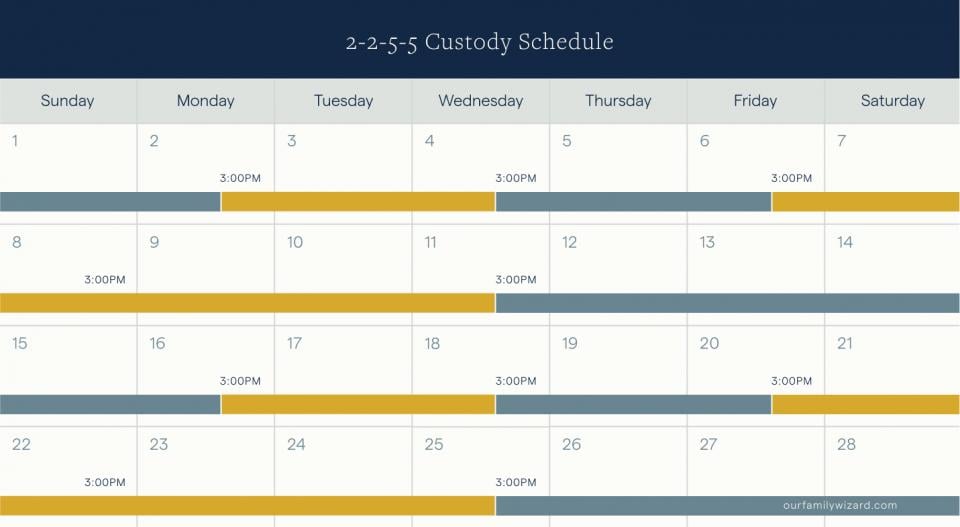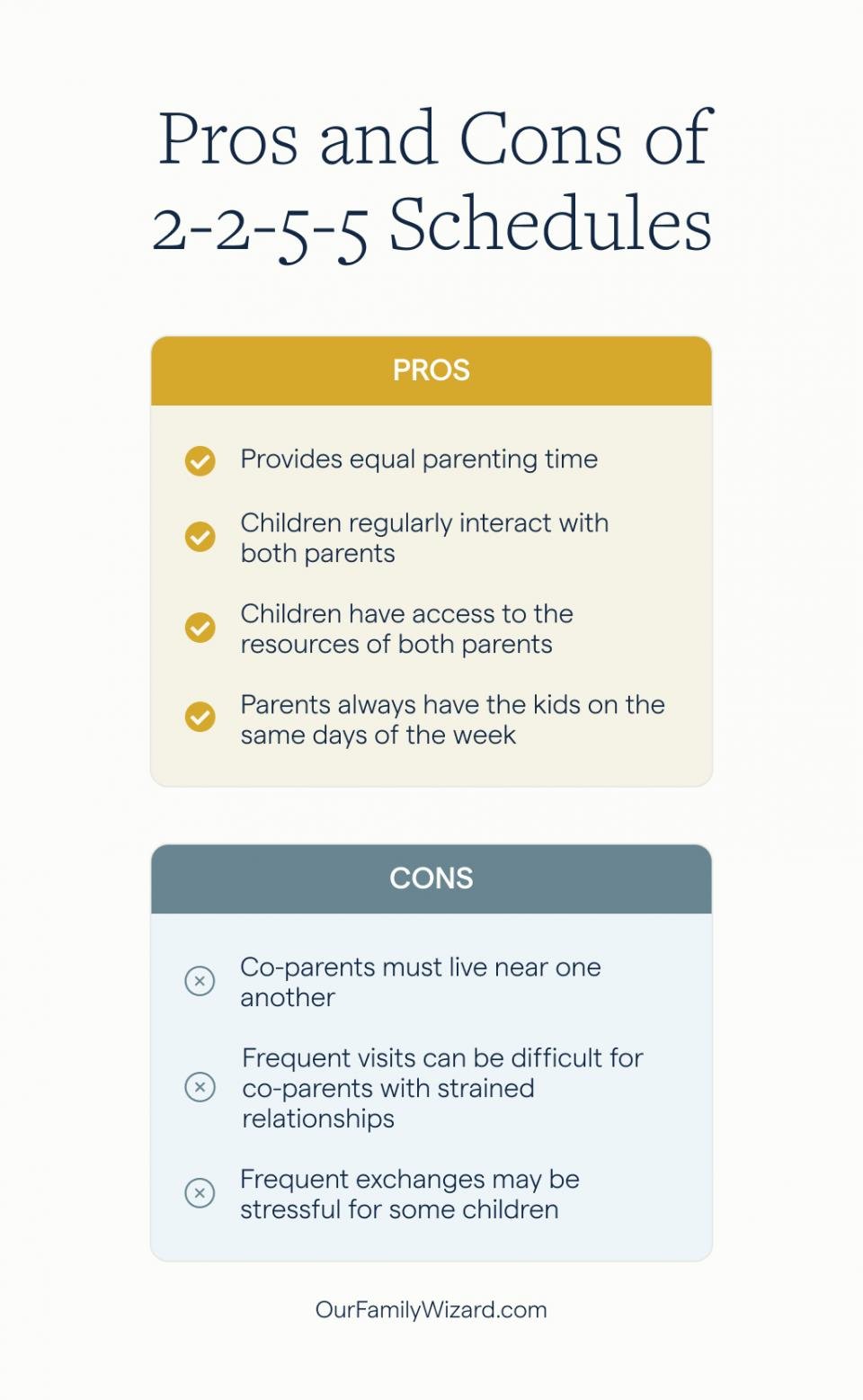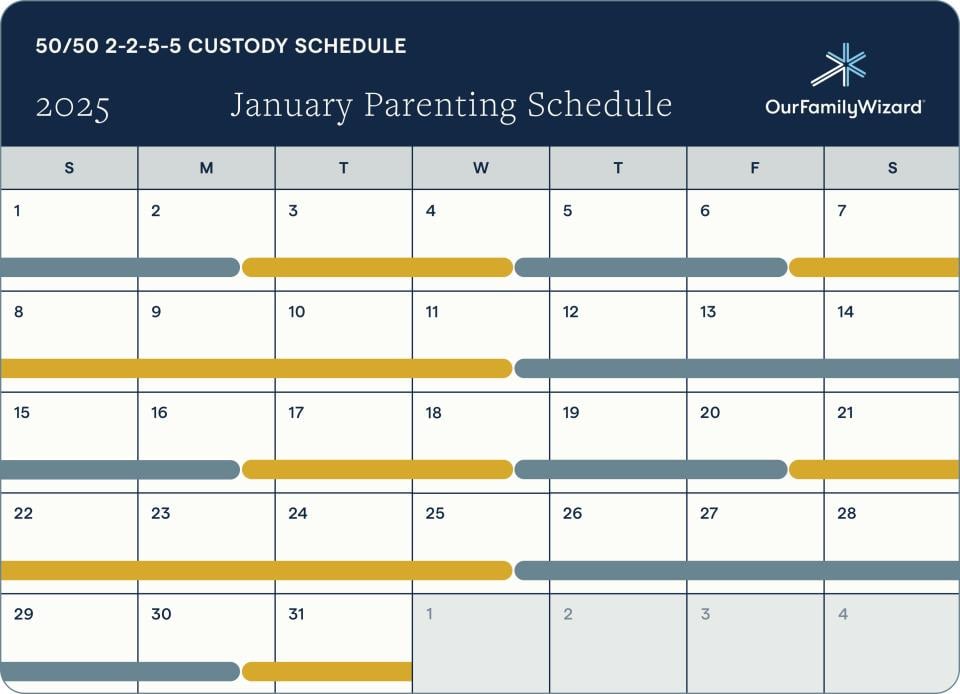2-2-5-5 Custody Schedules: Samples, Variations, Templates, and Expert Tips
A co-parenting schedule can help you raise a family across different homes. Check out this comprehensive guide on the popular 2-2-5-5 custody schedule. Download a free parenting schedule template, learn from expert tips, and see if this rotation will fit your family.
What Is a 2-2-5-5 Custody Schedule
A 2-2-5-5 custody schedule is a shared parenting rotation that splits parenting time 50/50. Parents split time into two-day and five-day blocks. Many experts like this schedule because parents keep the same days every week, making it easier to remember.
Key Takeaways:
- The 2-2-5-5 is a 50/50 parenting rotation that gives each co-parent equal time with kids over a two-week period.
- As with most 50/50 schedules, 2-2-5-5 works best for co-parents who live near one another and don’t have a high-conflict relationship.
- This schedule is best for younger kids, who will go only four full days without seeing a parent.
- The 2-2-5-5 schedule gives both co-parents a long weekend with the kids.
- A shared co-parenting calendar helps co-parents manage the 2-2-5-5 schedule.
You’ll often see the 2-5-5-2 schedule rotation referred to as a “custody schedule” or a “parenting schedule.”
Joint physical custody is a parenting arrangement where both parents have physical custody over their children. The children rotate their time living with each parent often on a set schedule. When deciding on a schedule, co-parents consider various aspects like work schedules, children’s schedules, children’s ages, and distance between housing to select a parenting plan that works for your unique situation. For those who want shared custody, a 50/50 split can be an attractive option.
50/50 custody schedules split parenting time equally. This schedule has grown in popularity, with many co-parenting feeling it is fair and gives kids adequate time with both parents. But a 50/50 custody schedule might not be right for all families. For one, splitting time down the middle introduces complexities that not all co-parents may be equipped to handle. Instead of one house being the dominant residence, parents with 50/50 custody must balance the logistical challenges of frequent exchanges with the emotional burden of long times apart.
might not be right for all families. For one, splitting time down the middle introduces complexities that not all co-parents may be equipped to handle. Instead of one house being the dominant residence, parents with 50/50 custody must balance the logistical challenges of frequent exchanges with the emotional burden of long times apart.
Terri Breer, a family law attorney and mediator from California, says co-parents have a lot to think about even when they have agreed to share parenting time equally. “While they may want a schedule that allows for equal parenting time with each parent, co-parents need to consider additional schedules. For example, there might be a better way to break up the weekly parenting schedule, particularly if their work schedules or children’s needs suggest a different arrangement.”
The 2-2-5-5 parenting plan offers many benefits for parents who decide that a shared schedule will work best for their children. This rotation keeps the days of the week consistent between co-parents and minimizes time apart.

How Does a 2-2-5-5 Parenting Plan Work?
In a 2-2-5-5 parenting plan, a child spends two nights with the first parent in the rotation and then two nights with the other parent. Then, the child spends five days with the first parent and five days with the other parent. In this schedule, each parent spends a long weekend with the kids.
Typically, co-parents start the 2-2-5-5 schedule on Monday. So, the first parent is with the kids for Monday and Tuesday. On Wednesday, they switch to their other parent’s home, where they stay for Wednesday and Thursday nights. On Friday, they’ll start a five-day stay back with the first parent.
Under this arrangement, one parent will always have Mondays and Tuesdays, and the other parent will have Wednesdays and Thursdays. Co-parents will switch the long weekend every other week. One long weekend will go from Friday to Wednesday, and the other will go from Wednesday to Monday. Another way to think about it is that whenever you have a five-day period, it will include your typical weekdays plus the long weekend.
Who Is a 2-2-5-5 Parenting Schedule Good For?
Co-parents who want to minimize time apart from their children and maintain a consistent schedule can excel under the 2-2-5-5 plan. The schedule works best for co-parents who live near one another and have younger children.
 Attorney James J. Sexton describes the 2-2-5-5 schedule this way: “A 2-2-5-5 provides the 50/50 split that so many people place emotional significance on, but without the problems inherent in an alternating week schedule. Rather than going a full week without seeing the children, in a 2-2-5-5 schedule you never go more than four days without seeing your children.”
Attorney James J. Sexton describes the 2-2-5-5 schedule this way: “A 2-2-5-5 provides the 50/50 split that so many people place emotional significance on, but without the problems inherent in an alternating week schedule. Rather than going a full week without seeing the children, in a 2-2-5-5 schedule you never go more than four days without seeing your children.”
Because each co-parent will have weekdays and weekends, both must be available to handle weekday pick-ups and enjoy kid-friendly weekend activities.
Here's a breakdown of the families that may excel with a 2-2-5-5 schedule. Note that some of these considerations may change as a child grows older.
- Co-parents live near one another and near the children’s school
With one mid-week transition, the 2-2-5-5 will work well only if both homes are near the children’s school. Likewise, if one co-parent lives far from another, commute times will add up to stress and frustration. - Parents with stable workweeks
Sexton notes: “With the 2-2-5-5, I can let my employer know they can count on me for late meetings or long hours on Wednesday and Thursday but that I can't be available for extended hours on Monday and Tuesday.” In contrast, parents who have jobs requiring on-call availability, like nurses, may have trouble sticking to this schedule. - Parents who communicate well
Though the days of the week stay the same in the 2-2-5-5, co-parents will still need to communicate well to schedule exchanges and discuss potential temporary modifications, like if one parent is out of town and needs the other to cover. Co-parents in a high-conflict relationship or who can’t tolerate communicating regularly may find the 2-2-5-5 difficult. - Parents with adequate resources to create two homes
When children travel between two houses every week, they can experience stress and a feeling that they don’t have a home base. Parents can alleviate this concern by making sure each home is well-stocked with everything the kids may need. This way, they won’t have to pack up too many things, strengthening the idea that they have two homes rather than none. - Young children and children with secure attachment
Research suggests that “young children need stability and predictability in their relationships with their careers since their first attachment relationships are still developing.”
Likewise, older children who already have formed secure attachments to their parents will not want to be away from either parent for too long.
How does a 2-2-5-5 Parenting Schedule Affect Children?
Maria Curran, licensed clinical mental health counselor supervisor (Master's level) in Charlotte, North Carolina, explains that a 2-2-5-5 schedule can be a great fit for some families—if you set clear expectations and you stay flexible.
Carolina, explains that a 2-2-5-5 schedule can be a great fit for some families—if you set clear expectations and you stay flexible.
Set clear expectations
In your parenting plan, make the schedule really detailed. That makes sure the child never feels any stress about which parent they’re going to be with, when. Curran asks, “What happens if there's a teacher work day or a snow day or a long weekend? If you have a parent who always has Monday and Tuesday, but Monday's a holiday, what time does that transition happen?”
Curran adds, “A lot of plans that I see now will say, ‘If Monday's a holiday, and it's a 2-2-5-5 schedule, then the exchange will still happen at the time the kids would normally go to school. School starts at 8:30, so the exchange is going to happen at 8:30.’ Don’t leave that open-ended.” Then your child will know what to expect, which is especially important on days when things feel different or unexpected.
Consider switching up the schedule in the summer
“In the summertime,” says Curran, “families on this schedule will often shift to week on week off, so that they can take vacations with the kids. And it's usually easier if they're doing camps because that way parents don't have to agree upon every single camp.” Then the children don’t feel like the center of conflict every week. Instead, they have new opportunities for new experiences.
Summer flexibility allows the kids and the parents to do some things that they couldn't otherwise do. Like attending a summer camp that is far from one parent, spending the summer with a relative, or going on family trips and vacations. Even if you do the 2-2-5-5, Curran explains, you can change it up in the summer.
Consider any special needs
“If you have a special-needs child, you might need to adapt the schedule,” says Curran. “If they're having a hard time with change and transition, or going longer periods of time without seeing one parent, then consider having an intermediate visit. Whichever parent gets the full five days, you could have a dinner or lunch—something built in, so that there is some sort of interim contact between the child who has special needs and the parent who’s not currently on duty.”
Consider everyone’s needs—which can change over time
Curran explains, “If I'm working with the parents of a really young child, like a baby or a toddler, I encourage them to set a time in their agreement to look at the schedule again and determine whether they need to tweak it. A good time would be when the child is transitioning from elementary school to middle school, and or from middle school to high school.
“Often, when kids start to get older, they don't want so many transitions. It's a naive assumption to think that what works for a toddler is going to work for a teen.” But considering everyone’s needs—both now and over time—helps you build a 2-2-3 schedule that sets you up for success.
Pros of 2-2-5-5 Custody Schedule
The 2-2-5-5 strikes a difficult balance. It offers a very structured, easy-to-remember schedule while also being designed around minimal time apart – the kids see each parent at least once a week. Also, both parents get weekend time with the kids.
Here are the pros of a 2-2-5-5 schedule:
- Easy-to-remember and structured schedule
Breer explains the benefits like this: “Many therapists, co-parenting experts, and family counselors often recommend the 2-2-5-5 schedule because it is easy for the child to know when they are going to be with which parent. For example, they always know that if it’s Monday or Tuesday, they are with Mom, and on Wednesday and Thursday, they are with Dad (or vice versa). All they need to remember is who is picking them up from school that afternoon – a much preferable alternative to schedules when they may be with parents on different days of the week throughout the month.”
Sexton adds: “It’s easy to explain a 2-2-5-5 schedule to young children because it involves a lot of ‘always’ variables: ‘You will always be with Mommy on Monday, and it's easy to remember because "M" is the first word of Mommy and of Monday.’ That's easier for a child to understand than a statement like, ‘If I had you for the weekend last weekend there will be an overnight on the following Wednesday.’ It's easier for adults to understand, too.”
Sexton notes that the consistency of the 2-2-5-5 schedule helps co-parents, too. “From a logistics standpoint, the 2-2-5-5 schedule allows for advance planning. I can also plan social activities, therapy appointments, or any other “grown up” activities that I want to do on my child-free nights – all without having to take out a calendar and count out the days and weeks.”
- Frequent contact between co-parents and kids
In the 2-2-5-5 schedule, kids see both parents each week, spending at most four nights with one parent before visiting the other. This level of contact is particularly important for younger children, says Breer, who compares 2-2-5-5 with other common 50/50 schedules, like alternating weeks.
“The 2-2-5-5 is better than sharing schedules that involve one week with one parent and one week with the other parent. For children younger than 11, one week may be too long to go without seeing the other parent. Although there are lots of ways to chat online with the other parent during the off week, most therapists familiar with custody schedules advise breaking up the physical custody periods with one parent when children are younger.”
- Both parents get weekend days
Weekends can be a coveted time for parents and kids to bond and relax. In the 2-2-5-5 schedule, co-parents alternate long weekends. As a result, each parent can experience the more regimented side of weekday parenting, which involves school and extracurricular activities, along with the fun weekend. This arrangement exposes both children to the different parenting styles of each co-parent.
Cons of 2-2-5-5 Custody Schedule
The 2-2-5-5 schedule will be difficult for parents who don’t want to communicate often. Also, some children will find it difficult to adjust to two primary homes. You can mitigate some of these challenges by ensuring both homes have everything the child needs.
The 2-2-5-5 schedule offers many benefits, but it’s not without challenges. Here’s a list of some potential issues with a 2-2-5-5 schedule:
- Some children might feel alienated from both homes
“The most common critique I hear from mental health professionals related to a 2-2-5 schedule,” Sexton says, “is that having two homes of equal measure often leads to a feeling of ‘homelessness’ for children as there is no primary home or home base.”
Co-parents can counter these feelings by ensuring both homes are well-stocked with their favorite items, making the children feel that they have two true homes.
- Parents must be able to communicate well
To coordinate school drop-offs and pick-ups, the 2-2-5-5 demands that parents communicate well. Co-parents in high-conflict relationships may consider a different type of schedule that minimizes exchanges.
But, as Breer points out, the 2-2-5-5 schedule can accommodate co-parents with tense relationships.
“One benefit of the schedule is that it avoids ‘triangulating’ the child between the parents during the pick-up and drop-offs. There is simply one parent picking up the child to carry out the schedule. With advance planning, this schedule can help when a child is upset with separating from a parent, or if parents are high-conflict and tend to act out in front of their children during transitions.”
- Parents must live near one another
Given the multiple exchanges, this schedule won’t work for parents who live far apart. In general, it’s ideal if parents live within 10 to 15 miles and in the same school district. Otherwise, parents, kids, and caregivers will spend long periods commuting, which can become tiresome and unhealthy for everyone involved.
Examples of 2-2-5-5 Child Visitation Schedules
You can try a variation of the 2-2-5-5 schedule to fit your unique scheduling needs. These variations all start on different days but maintain the same two-week rotation. To better understand your options, check out different variations of the 2-2-5-5 schedule: 5-2-2-5, 5-5-2-2, and 2-5-5-2.
Example of a 2-2-5-5 Custody Schedule
The 2-2-5-5 schedule is set up so that, if the rotation begins on Monday, both parents get alternating long weekends. But you can keep alternating weekends by starting some of the following variations on different days. Some co-parents can’t watch the kids over the weekends, and others may have very specific work schedules that make certain days off-limits.
The following variations may work better than 2-2-5-5 for families with unique scheduling needs.
5-5-2-2 Custody Schedule
Here, co-parents start with five-day blocks rather than two-day blocks. After both co-parents have had the kids for five days, they then alternate a two-day rotation. Most co-parents start 5-5-2-2 on Wednesday or Friday so they can alternate the long weekend (Friday-Sunday).
Example of a 5-5-2-2 Custody Schedule
2-5-5-2 Custody Schedule
The 2-5-5-2 schedule starts and ends the two-week rotation with a two-day block. The first parent in the rotation has the kids for two days, and then the other parent has them for five. Now, the first parent alternates for five days, with the other parent ending the rotation with two days. If the schedule starts on a Monday, the first parent in the rotation won’t get any weekend time with the kids.
Example of a 2-5-5-2 Custody Schedule
5-2-2-5 Custody Schedule
In this variation, co-parents usually start the schedule on Wednesday. The first parent in the rotation has the kids for four overnight visits (Wednesday-Sunday), and then the other parent has them for two days (Monday-Tuesday), and that same parent takes them for another two days (Wednesday-Thursday). Now it’s the first parent’s turn to have the kids for five days, including the long weekend (Friday-Tuesday). Overall, this schedule alternates the long weekends.
Example of a 5-2-2-5 Custody Schedule
Free 2-2-5-5 Custody Schedule Template
Use this free 2-2-5-5 custody schedule template to see how your parenting schedule may look. Experiment with different exchange days and variations to determine which rotation will fit your family best.
Envisioning how a parenting schedule will work can be confusing. Instead of trying to map it out in your head, add your family’s obligations, schedules, and events onto a prebuilt and printable custody schedule. Immediately, you’ll notice issues, opportunities, and challenges. Then, you can tinker with different exchange days and decide if the schedule will help your family.
Simplify your 50/50 custody schedule
Keep your co-parenting organized with OurFamilyWizard.
Questions to Ask When Considering a 2-2-5-5 Parenting Schedule
Before settling on a 2-2-5-5 schedule, consider going over some questions as a family to make sure the rotation will work well for everyone. For example, co-parents should honestly assess if their relationship can handle frequent exchanges. Also, ask your kids what they think.
Here's a list of questions that co-parents should discuss to determine if the 2-2-5-5 schedule will be the right fit:
- Will a midweek transition introduce logistical challenges?
- Do my co-parent and I live close enough to each other for commuting to work? (Typically, no more than 10 to 15 miles apart.)
- Do my co-parent and I have a comfortable, communicative relationship where they can both attend extracurricular activities midweek and handle frequent exchanges?
- Does the 2-2-5-5 schedule interfere with our work schedules?
- Are our kids comfortable in both homes? Do they have everything they need in both homes?
- How old are our kids? Are they still forming a secure attachment with both parents? Will they benefit from frequent contact?
Alternatives to 2-2-5-5 Parenting Schedules
Explore common alternatives to the 2-2-5-5 parenting schedule that still provide 50/50 custody. For example, co-parents who want fewer exchanges may consider alternating week schedules. Those that want to spend less time apart should check out the 2-2-3 schedule.
Here are three alternative schedules to the 2-2-5-5 that vary in the number of exchanges and the time kids spend apart from each parent.
- 3-4-4-3 custody schedule
In a 3-4-4-3 parenting schedule, the first parent has the kids for four overnight visits, and then the second has them for three. Next week, the days swap: The first parent has the kids for three days, and the second has them for four. This schedule resembles the 2-2-5-5 most closely but doesn’t give both parents a long weekend visit. - 2-2-3 custody schedule
The 2-2-3 custody schedule minimizes the time kids spend apart from co-parents. In this schedule, parents alternate two-day and three-day blocks with the kids. The frequent exchanges can be difficult to keep track of, and the days of the week per parent change. - Alternating weeks custody schedule (week on/week off custody)
In the week-on/week-off custody schedule, each parent spends a whole week with their children at a time. Consequently, parents and children go seven days at a time without seeing one another. In many cases, parents add-in a visit here or there to the alternating week schedule, like alternating weeks with one mid-week overnight stay at the other parent’s house. - 2-week schedule
Co-parents who live far apart may prefer the two weeks each custody schedule. Under this rotation, kids stay with each parent for two weeks. However, two weeks may be too much time apart for younger children.

Easiest Way to Manage 2-2-5-5 Visitation Schedules
OurFamilyWizard understands that to manage a family across two homes, a regular calendar won’t do. That’s why they designed a shared calendar and communication tools for co-parents. Managing a 2-2-5-5 schedule has never been easier.
Breer knows firsthand that communication between co-parents can be tricky. “I always recommend that parents use an app like OurFamilyWizard to assist with parenting communication whether they are perfect pals or angry foes in their co-parenting relationship.”
OurFamilyWizard’s shared Calendar app has all the features you need to keep your family in sync with the 2-2-5-5 schedule. Requesting extra weekend time or navigating the holidays will be less stressful with tools like schedule change requests and the holiday scheduler. The single shared parenting schedule minimizes conflict, improves communication, and alleviates stress.
A Note on Terminology
In general, the term “physical custody” refers to which parent a child lives with. Today, many experts use other terms to describe this arrangement, like “parenting schedule” or “parenting time arrangement.” These new terms better represent a relationship and the parent’s responsibilities for their children. But just a heads up: this article uses these older and newer terms interchangeably.








